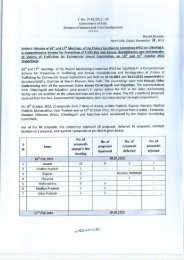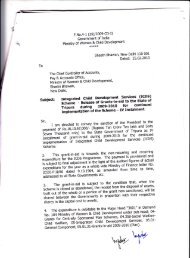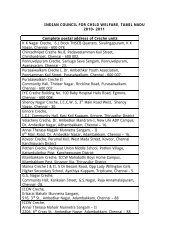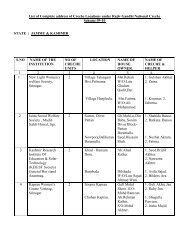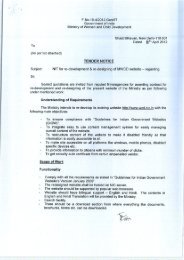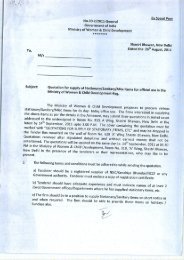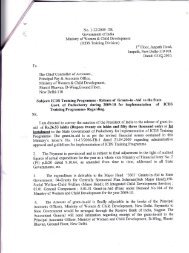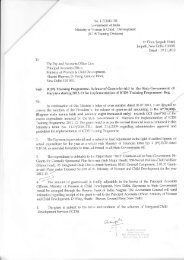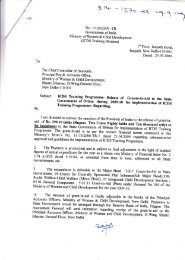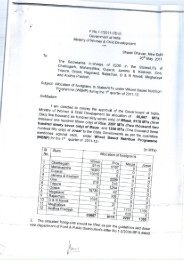COVER HINDI - Ministry of Women and Child Development
COVER HINDI - Ministry of Women and Child Development
COVER HINDI - Ministry of Women and Child Development
- TAGS
- hindi
- ministry
- wcd.nic.in
You also want an ePaper? Increase the reach of your titles
YUMPU automatically turns print PDFs into web optimized ePapers that Google loves.
<strong>Child</strong> Budgeting:<br />
CHAPTER-7<br />
Translating Outlays into Outcomes<br />
7.1 In its Annual Reports <strong>of</strong> 2002-03 <strong>and</strong> 2004-05, the<br />
<strong>Ministry</strong> <strong>of</strong> <strong>Women</strong> <strong>and</strong> <strong>Child</strong> <strong>Development</strong> (MWCD) had<br />
undertaken a series <strong>of</strong> analyses on ‘<strong>Child</strong> Budgeting’. In<br />
2004-05, the <strong>Ministry</strong>’s Annual Report had noted that<br />
budget outlays by the Union Government <strong>and</strong> States on<br />
children’s issues showed an increased commitment<br />
although actual expenditures ‘may however fall short <strong>of</strong><br />
budgets for reasons like lack <strong>of</strong> capacity to spend/ absorb<br />
funds, procedural delays, slackness in implementation’.<br />
The <strong>Ministry</strong> took forward this analytical work <strong>and</strong><br />
commitment in several ways. In October 2005, it held a<br />
one-day workshop in New Delhi inviting <strong>of</strong>ficials<br />
representing Finance <strong>and</strong> <strong>Women</strong> <strong>and</strong> <strong>Child</strong> <strong>Development</strong><br />
Departments from the States. This workshop had focused<br />
on the importance <strong>of</strong> ‘<strong>Child</strong> Budgeting’ <strong>and</strong> provided the<br />
framework for analysis for States to follow. In particular,<br />
the workshop had highlighted the gaps between outlays<br />
for children <strong>and</strong> the outcomes that are arising in relation<br />
to key child-related indicators: mortality, nutrition, <strong>and</strong><br />
education, amongst others.<br />
7.2 Analysis <strong>of</strong> the outlays made in the budget <strong>and</strong> the<br />
actual expenditures incurred subsequently on different<br />
sectors/ programmes/ schemes point to the priorities <strong>of</strong><br />
the government. It must be noted here that better outcomes<br />
in any sector, for instance, in education, health or nutrition,<br />
depend not just on the outlays but also on proper utilization<br />
<strong>of</strong> those outlays. In India, there are many non-financial<br />
constraints that impede progress in several sectors,<br />
especially in the social sectors. However, financial<br />
constraints could pose serious challenges to developments<br />
in the social sectors, <strong>and</strong> hence the focus on identifying<br />
such constraints <strong>and</strong> advocating for their removal should<br />
be emphasized. The National Common Minimum Program<br />
(NCMP) had reiterated the present Union Government’s<br />
commitment to rapid economic growth <strong>and</strong> targeted<br />
investments aimed at the marginalised sections <strong>of</strong><br />
population. The NCMP had outlined important targets<br />
related to public spending on key services, including the<br />
following: total public spending on education to be raised<br />
to 6% <strong>of</strong> GDP- with at least half to be spent on primary<br />
<strong>and</strong> secondary education, total public spending on health<br />
to be raised to at least 2% - 3% <strong>of</strong> GDP- focusing mainly<br />
on primary health care, by 2009-10.<br />
Challenges in the Social Sector<br />
7.3 Significant results have been achieved for children<br />
<strong>and</strong> women in India over the past decade in pursuit <strong>of</strong> the<br />
Millennium <strong>Development</strong> Goals (MDGs). There have also<br />
been several important policy developments. However,<br />
many trends in key human development indicators must<br />
accelerate if the national development targets – which are<br />
in line with <strong>and</strong> at times more ambitious than the MDGs –<br />
are to be met.<br />
Box1:<br />
Tenth Five Year Plan (2002-07) Goals for <strong>Women</strong><br />
<strong>and</strong> <strong>Child</strong>ren<br />
The Tenth Five Year Plan (2002-07) had set the<br />
following goals <strong>and</strong> targets for women <strong>and</strong> children.<br />
all children in school by 2003; all children to<br />
complete five years <strong>of</strong> schooling by 2007<br />
reduction in gender gaps in literacy <strong>and</strong> wage rates<br />
by at least 50 percent by 2007<br />
reduction in Infant Mortality Rate (IMR) to 45 per<br />
1000 live births by 2007 <strong>and</strong> 28 by 2012<br />
Reduction <strong>of</strong> Maternal Mortality Rate (MMR) to<br />
2 per 1000 live births by 2007 <strong>and</strong> to 1 per 1000<br />
live births by 2012<br />
Other notable objectives are:<br />
to arrest the decline in the child sex ratio<br />
increasing representation <strong>of</strong> women in premier<br />
services <strong>and</strong> in Parliament<br />
Universalisation <strong>of</strong> the Integrated <strong>Child</strong><br />
<strong>Development</strong> Services (ICDS) scheme<br />
<strong>Child</strong> Budgeting: Translating Outlays into Outcomes 119



